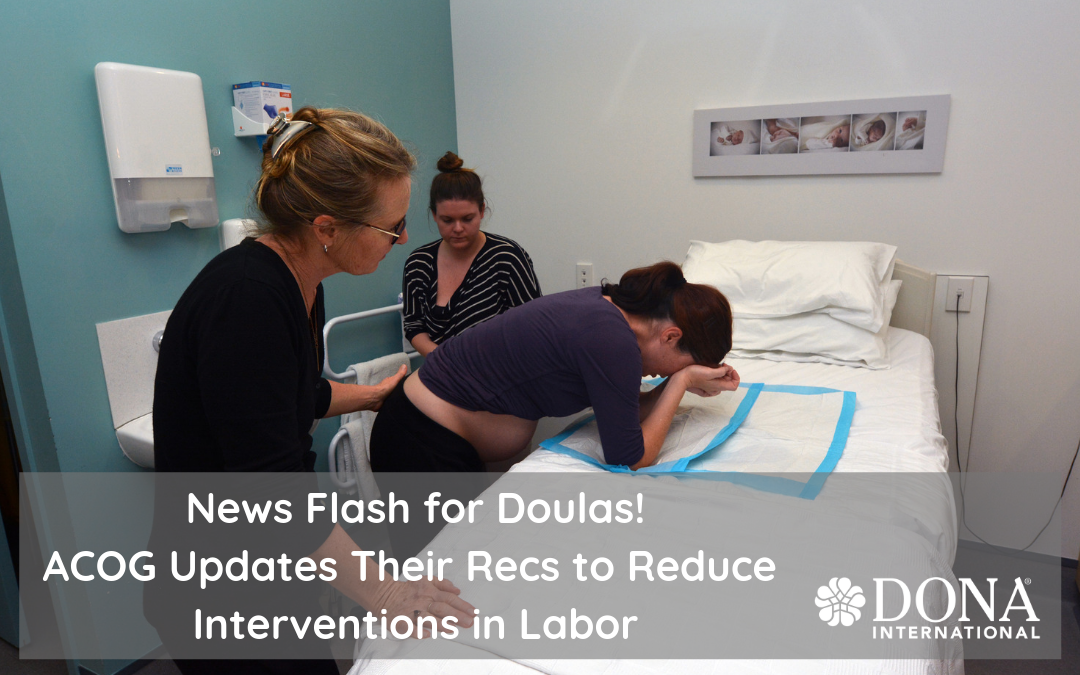By Sharon Muza, BS, CD(DONA), BDT(DONA), LCCE, FACCE, LCE
Introduction
Just about two years ago, the DONA Doula Chronicles blog shared about the American College of Obstetricians and Gynecologists (ACOG) Committee Opinion released in 2017 regarding recommendations to reduce interventions and improve birth outcomes. This opinion was endorsed by the American College of Nurse-Midwives (ACNM) and the Association of Women’s Health, Obstetric and Neonatal Nurses (AWHONN). While there were ten suggestions, I had selected the six most important ones that I felt doulas should be sharing with their clients and covered those items in this post “Six New Care Recommendations that Every Birth Doula Should Be Sharing with Their Clients.”
Updated Committee Opinion
In January 2019, ACOG updated their groundbreaking committee opinion, with a changed recommendation that concerned pushing with an epidural. “Approaches to Limit Intervention During Labor and Birth 2019” now recommends birthing people not labor down with an epidural but rather begin pushing when they are completely dilated. Additionally, ACOG included recommendations for Labor & Birth units offering components of family-centered cesareans.
Unchanged Recommendations
The recommendations that were discussed in the original blog post and remained from the original committee opinion include:
- Hospitals encourage laboring at home until active labor
- Active and expectant management of PROM are both equally good choices for GBS negative people
- Doulas are associated with improved outcomes
- Intermittent fetal heart rate monitoring is appropriate for low-risk labors
- Artificial rupture of membranes in labor is not necessary
- Nonpharmacological coping techniques can help
- People should choose comfortable positions to labor in
- Eat, drink and labor on!
- Push spontaneously with the urge to push
Two New Recommendations
The two new recommendations in the updated 2019 Committee Opinion: Approaches to Limit Intervention During Labor and Birth 2019 include:
- Immediate pushing when completely dilated for people with an epidural
- Family-centric cesareans should be accommodated when appropriate
Let’s take a closer look at these new recommendations.
Immediate Versus Delayed Pushing for Nulliparous Women Receiving Epidural Analgesia
Based on new research in 2018 along with two meta-analyses of randomized control trials, ACOG’s new recommendation states that “collectively, and particularly in light of recent high- quality study findings, data support pushing at the start of the second stage of labor for nulliparous women receiving neuraxial analgesia. Delayed pushing has not been shown to significantly improve the likelihood of vaginal birth and risks of delayed pushing, including infection, hemorrhage, and neonatal acidemia should be shared with nulliparous women receiving neuraxial analgesia who consider such an approach.”
Birth doulas should be aware of this new research and assist clients in discussing their preferences with their health care providers. Doulas can also continue to assist clients with epidurals in using productive positions that promote second stage progress.
Family-Centered Cesarean Birth
ACOG acknowledges that there are people intending to give birth vaginally who may end up with a planned or unplanned cesarean for a variety of reasons. When a cesarean is necessary, ACOG states that “birthing units should carefully consider adding family-centric interventions (such as lowered or clear drapes at cesarean delivery) that are otherwise not already considered routine care and that can be safely offered, given available environmental resources and staffing models. These family-centric interventions should be provided in recognition of the value of inclusion in the birthing process for many women and their families, irrespective of delivery mode.”
Prenatally, birth doulas can and should discuss family-friendly cesarean birth options and encourage clients to have a conversation about the choices a family may have if a cesarean birth is necessary. We know that women will give birth by cesarean even if that was not their original intention. Being prepared to advocate for themselves can go smoother if the laboring person and their family have given consideration to and discussed their options with their provider in advance.
Conclusion
Maternal-infant care organizations are acutely aware of the fact that interventions during labor and birth are at an all-time high and outcomes are poor. For parents of color and their babies, the impact is even more acute. ACOG’s Committee Opinion Approaches to Limit Intervention During Labor and Birth 2019 focuses on evidence-based and effective ways of reducing interventions and improving outcomes. Doulas owe it to themselves and to their clients to be familiar with these simple but effective recommendations and be prepared to discuss them with their clients when asked. Change is achievable when people are informed and practice evidence-based medicine. Doulas can be a part of that change through client support and information.



Sharon, thank you for keeping us up-to-date with your valuable information.
very important information for doulas to share with their clients
I’m a bit confused…so newer research has shown that “laboring down” with an epidural does NOT shorten the pushing process? I know I haven’t had huge numbers of Mama’s as with a study, but that has not been my experience. Any others have observations in regard to this?
There is more to Family Centered Cesarean (also called Gentle Cesarean) than clear drapes.
No separation from partner
Walk to the OR when able
Delayed cord clamping
Immediate skin to skin with mom or dad
Breastfeeding the the OR when possible
These are all very doable it just requires some adaptation and can make such a difference to families.